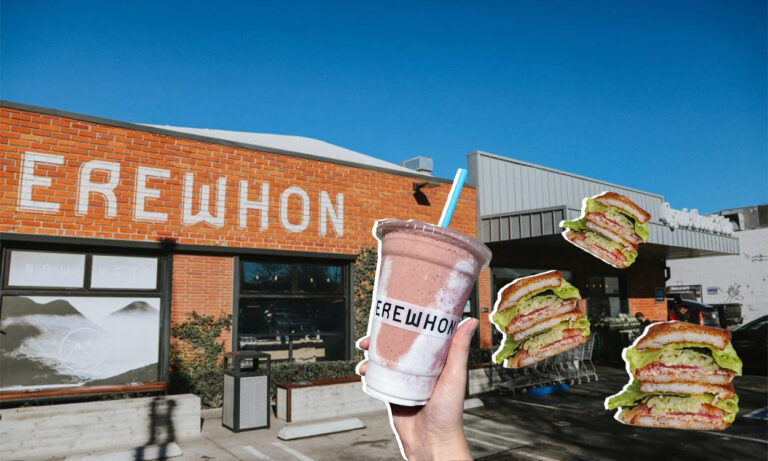What is affordable affluence, and why is Erewhon everywhere?

At this point, you’re probably familiar with quiet luxury. If not, fashion editor Harry Archer defines it as “new-age minimalism, with a larger focus on investment pieces and thoughtful shopping habits.” Think earth tones, well-tailored silhouettes and a complete absence of showy logos—in other words, it’s the opposite of the logomania that dominated the late 2010s, or even the maximalism trend we’ve been seeing as of late. It’s more Shiv Roy, rather than Kim Kardashian.
As SCREENSHOT’s fashion expert, Jennifer Raymont puts it, “Obnoxious displays of wealth are no longer the best way to elevate yourself above mere mortals, empathy and stealth wealth are.” While quiet luxury highlights the growing distance between one-percenters and everyone else, affordable affluence can be seen as a way for the latter to feel like the former. Think of it as quiet luxury’s cousin, if not sibling; the two go hand-in-hand.
I first came across the phrase “affordable affluence” in Hannah Jackson’s article for The Cut titled Meet the People Working 3 Jobs to Afford Erewhon. One of her interviewees, Andrea Hernández, founder of Snaxshot, succinctly described the trendy and infamously overpriced Los Angeles grocery store as the epitome of “affordable affluence.” In other words, “a way for regular people to position themselves adjacent to the upper class,” Jackson clarifies.
@shawnthefoodsheep Come with me to the Most Expensive Grocery Store in Los Angeles, Erewhon! #erewhon #groceryshopping #foodie #CapCut
♬ Blue Blood - Heinz Kiessling
“Maybe you can’t afford to have a house because of the housing crisis and inflation and everything is so expensive, but you have Erewhon,” explains Hernández—and therein lies the sweet spot of affordable affluence. So, why is affordable affluence having a moment now? Let’s get into it.
While the phrase affordable affluence may seem trendy (aka bound to disappear in a few months’ time) it’s actually the result of a business tactic that’s been in the works for years from some of your favourite brands.
Take Aritzia, for example. During the pandemic, the retailer pivoted to what CEO of Sharma Brands, Nik Sharma, calls a high-low strategy. The concept has two pillars: partnering with celebrities and micro-influencers. You’ve probably seen the brand’s iconic Super Puff coat on one of the Jenners, Bella Hadid, Emma Chamberlain, and even J.Lo, but you’ve no doubt also seen it worn by plenty of local it girls while you’re out and about or scrolling through Instagram.
As a result, Aritzia effectively becomes an aspirational brand worn by A-listers, while also remaining at (somewhat) accessible price points for the average consumer.
Affordable affluence 👀 https://t.co/hrFOPVvQGC
— Andrea (@iiiitsandrea) May 12, 2023
According to a 2018 study, celebrity endorsements address “the consumer need from a psychological angle. Consequently, it influences [their] conduct and decision-making toward the promoted product or brand.” While Aritzia offers a great example of this statement put into action, Erewhon hands down does it best. You may have been introduced to the grocery store via the viral TikTok clip in which a celebrity private chef creates a $1,000 ice cream sundae—or one of the many other Erewhon haul or smoothie taste test videos out there.
@chefbae Part☝🏼: The most @erewhonmarket ice cream sundae to exist. #chefbae . . . #erewhon #erewhonhaul #celebrityprivatechef #laprivatechef #erewhonrecipes #privatechefla
♬ original sound - Chef Bae
What was once a mid-century local health food store in Boston has become LA’s trendiest new supermarket. The brand has garnered attention on social media (namely TikTok) for its unique offerings at eye-watering prices. Some examples include hyper-oxygenated water (£20.93 for 64 oz.), truffle-infused hot sauce (£32.21 for 6 oz.), vegan pesto (£16.90 for 11 oz.) and, last but definitely not least, an Erewhon tote bag (£181.06).
So, what does this all have to do with affordable affluence? In 2023, many retailers effectively use celebrity and influencer endorsements to create brand familiarity, of course, but also to establish a deeper connection with consumers. By seeing celebrities wear, purchase or consume the same products, the average shopper feels that they’re tapping into the lifestyles of the ultra-elite without—in most cases—being able to afford it.
That being said, middle-class consumers are able to purchase some of the signals of wealth (read: a £32 hot sauce) and incorporate them into their daily lives. Whereas renting private jets just isn’t attainable for most, forking over an extra portion of your paycheck to purchase the same foods and clothing items your favourite celeb is wearing is to a degree. As displays of wealth become less visibly ostentatious, they become somewhat more aspirational for the general buyer or social media user.
Unsurprisingly, all of this is true for Erwehon. The retailer has skyrocketed to the limelight due to its many celebrity connections. Not only has the supermarket collaborated with A-listers (think the Hailey Bieber, Bella Hadid and Kourtney Kardashian smoothies), but it’s also become known as a celeb hotbed. Nepo baby sightings are a regular occurrence at the stores, and the fact that it’s only located in LA just adds to its exclusivity.
“Those who know about Erewhon are in the know. They get to signal that,” says Hernández. Erewhon, Aritizia, and other brands that revel in this affordable affluence space, offer middle-class consumers the symbol of wealth, allowing them to participate in this exclusive culture in small ways.
As Luba Kaplanskaya, another interviewee in Jackson’s article puts it: “To just be in a comfortable sweat suit or a Lulu[lemon] fit and then have Erewhon? I feel like I’m worth a billion dollars.” That said, access to signals of affluence do provide some consumers with a confidence boost, despite increasing financial uncertainty for gen Z and millennials. While it still comes at a costly price tag, it’s easy to see how affordable affluence can offer some comfort.




